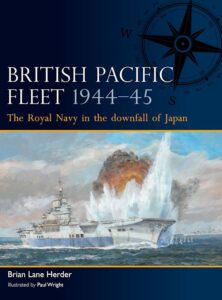Brian Lane Herder, British Pacific Fleet 1944-45 (Osprey, 2023)
Victory in the Pacific in 1945 is largely remembered as a US Navy success, and rightly so; but the Royal Navy played its part too, providing carriers and other warships to the final campaigns to defeat Japan. In this volume of Osprey’s Fleet series, Brian Lane Herder takes readers inside the British Pacific Fleet to examine how it impacted those late war naval operations.
Herder begins with the British Pacific Fleet’s purpose, which was to serve as a Task Force alongside the US fleets that were steadily reducing the Japanese war machine across the Pacific. This was a somewhat reluctant marriage because of differing Anglo-American political agendas, but once military objectives were apportioned by the end of 1944, the Royal Navy was soon underway. Herder surveys the ships that took part in the British Pacific Fleet with the fleet carriers taking pride of place, though they were ably supported by light carriers, battleships, cruisers, destroyers, and submarines. Herder notes that the crews included Commonwealth sailors. He also reviews the variety of warplanes the RN carried, including the superior US planes such as the Corsair and Hellcat. How the fleet cooperated with the Americans follows, with Herder considering command, formations, communications, logistics, and the roles of maintenance carriers along with escort and convoy carriers – the fleet formations are accompanied by excellent graphics. Herder annotates the actions the BPF undertook in Operations Robson, Iceberg, and Inmate, and their part in the naval siege of Japan in July-August 1945. This includes accounts of the fighting, with the kamikaze attacks standing out as arguably the most terrifying moments a sailor can endure. In his analysis of the BPF, Herder praises the men while blaming Churchill for the late arrival of the fleet and its relative unpreparedness.
Herder writes well and provides his readers with an informative overview of the British Pacific Fleet. He packs a lot of detail into a short introductory book but adds a useful bibliography for further exploration. Herder also does a very good job of placing the fleet in its military and political context without losing sight of the immediacy of the situation the men and ships encountered against a beaten but not yet defeated enemy. It is clear from Herder’s account that the Royal Navy played a significant role in the final demise of Japan. Overall, this is another excellent addition to the Osprey Fleet series.
